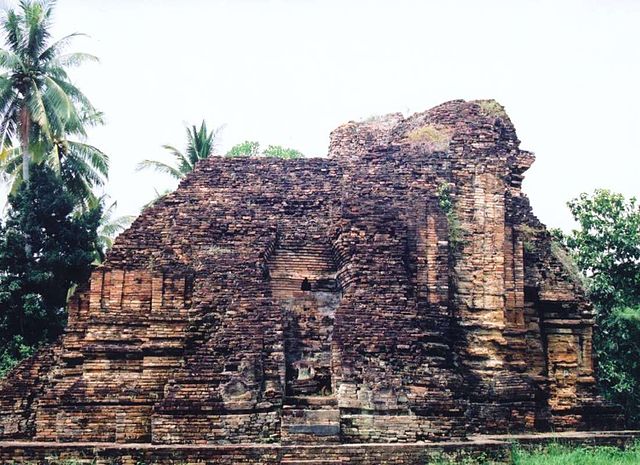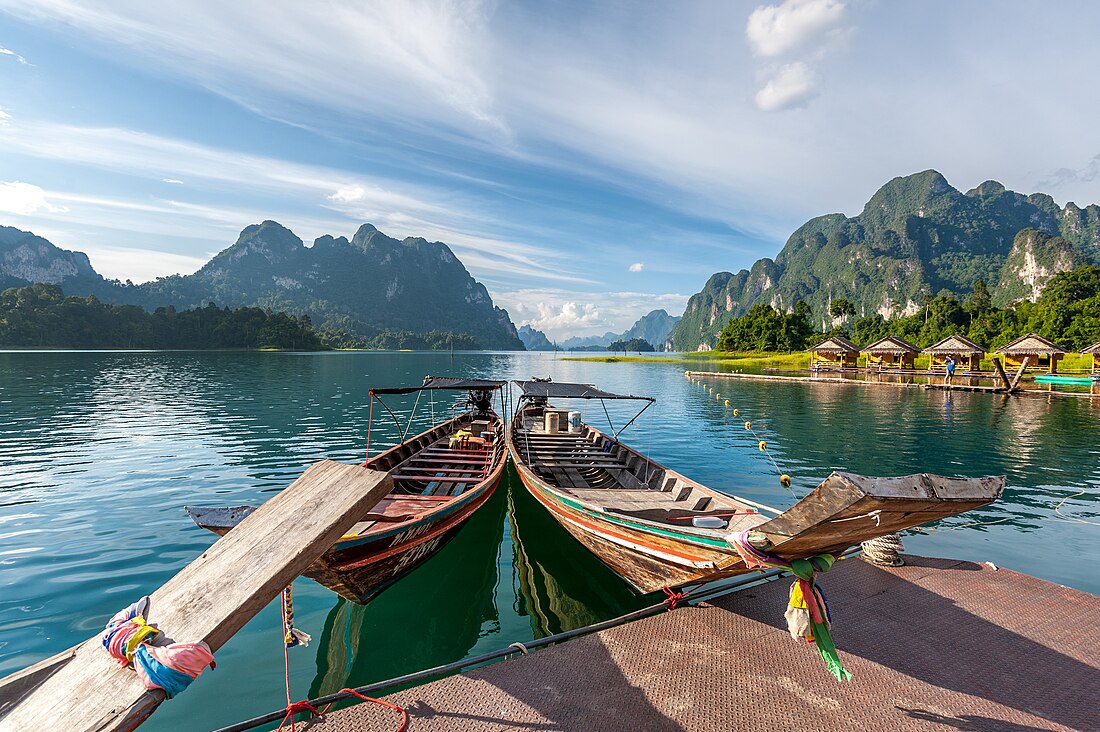Surat Thani province
Province in Thailand From Wikipedia, the free encyclopedia
Surat Thani (Thai: สุราษฎร์ธานี, pronounced [sù.râːt tʰāː.nīː]), often shortened to Surat, is the largest of the southern provinces (changwat) of Thailand. It lies on the western shore of the Gulf of Thailand. Surat Thani means 'city of good people', a title given to the city by King Vajiravudh (Rama VI); Surat Thani is therefore the sole province in Southern Thailand for which the native name is in the Central Thai language.
This article is written like a travel guide. (November 2019) |
Surat Thani
สุราษฎร์ธานี | |
|---|---|
 | |
| Nickname: Surat | |
| Motto(s): เมืองร้อยเกาะ เงาะอร่อย หอยใหญ่ ไข่แดง แหล่งธรรมะ ("The city of a hundred islands. Delicious rambutans. Large shellfish. Red (salted) eggs. The center of Dharma.") | |
 Map of Thailand highlighting Surat Thani province | |
| Country | Thailand |
| Capital | Surat Thani |
| Government | |
| • Governor | Teeruth Supawiboonpol |
| Area | |
• Total | 13,079 km2 (5,050 sq mi) |
| • Rank | 6th |
| Population (2024)[2] | |
• Total | 1,076,666 |
| • Rank | 20th |
| • Density | 82/km2 (210/sq mi) |
| • Rank | 59th |
| Human Achievement Index | |
| • HAI (2022) | 0.6438 "average" Ranked 35th |
| GDP | |
| • Total | baht 211 billion (US$6.7 billion) (2019) |
| Time zone | UTC+7 (ICT) |
| Postal code | 84xxx |
| Calling code | 077 |
| ISO 3166 code | TH-84 |
| Website | suratthani |
Surat Thani Provincial Administrative Organization
องค์การบริหารส่วนจังหวัดสุราษฎร์ธานี | |
|---|---|
 | |
| Government | |
| • Type | Local administrative divisions |
| • Body | Surat Thani Provincial Administrative Organization |
| • President | Sopa Kanchana |
| Website | suratpao |
Geography
Summarize
Perspective
Surat Thani Province, located in Thailand, is bordered by the provinces of Chumphon to the north, Nakhon Si Thammarat to the east, Krabi to the south, Phang Nga to the southwest, and Ranong to the northwest.
The geographic landscape of Surat Thani is diverse. The central region of the province is dominated by the coastal plain of the Tapi River, characterized by a mix of grassland, rubber trees, palm oil trees, and coconut plantations. To the west lie the limestone mountains of the Phuket range, largely enveloped in forest, home to the renowned Khao Sok National Park. The eastern part of the province sees the commencement of the Nakhon Si Thammarat (or Bantat) mountain range, a portion of which is preserved within Tai Rom Yen National Park. The total forest area in Surat Thani is approximately 3,764 km2 (1,453 sq mi), accounting for 28.8 percent of the province's area.[5]
Several islands in the Gulf of Thailand are part of Surat Thani, including popular tourist destinations such as Ko Samui, Ko Pha Ngan and Ko Tao, as well as the Ko Ang Thong Marine National Park.
The province is also defined by its main waterways, the Tapi River and the Phum Duang River, which converge near the town of Tha Kham before emptying into Bandon Bay. The delta formed by these rivers, known locally as Nai Bang (ในบาง), is situated directly north of Surat Thani city. This delta features a network of channels interspersed with small islands, predominantly covered by mangroves and orchards.
National parks
There are a total of eight national parks, six of which are in region 4 (Surat Thani) and Hat Khanom–Mu Ko Thale Tai and Namtok Si Khit are in region 5 (Nakhon Si Thammarat) of Thailand's protected areas.
- Khao Sok National Park, 739 km2 (285 sq mi)[6]: 22
- Kaeng Krung National Park, 541 km2 (209 sq mi)[6]: 69
- Tai Rom Yen National Park, 425 km2 (164 sq mi)[6]: 73
- Khlong Phanom National Park, 410 km2 (160 sq mi)[6]: 102
- Hat Khanom–Mu Ko Thale Tai National Park, 312 km2 (120 sq mi)[7]: 16
- Namtok Si Khit National Park, 145 km2 (56 sq mi)[6]: 95
- Mu Ko Ang Thong National Park, 102 km2 (39 sq mi)[6]: 21
- Than Sadet–Ko Pha-ngan National Park, 43 km2 (17 sq mi)[6]: 132
Wildlife sanctuaries
There are two wildlife sanctuaries, along with five other wildlife sanctuaries, make up region 4 (Surat Thani) of Thailand's protected areas.
- Khlong Saeng Wildlife Sanctuary, 1,155 km2 (446 sq mi)[8]: 12
- Khlong Yan Wildlife Sanctuary, 488 km2 (188 sq mi)[8]: 13
History
Summarize
Perspective
The region of Surat Thani has a long history of human habitation, dating back to prehistoric times. It was initially inhabited by indigenous Semang and Malayan tribes. In the 3rd century, the area came under the influence of the Srivijaya kingdom, a powerful entity that controlled much of the Malay Peninsula until the 13th century. The city of Chaiya, located in modern-day Surat Thani, is home to several archaeological ruins from the Srivijaya period, indicating its historical significance. There is a belief among some Thai historians that Chaiya may have served as a regional, or possibly even the primary capital of the Srivijaya kingdom, although this assertion remains a subject of scholarly debate. Another notable settlement from this era was Wiang Sa, which also played a significant role during the time of Srivijaya's dominance.

Following the decline of the Srivijaya kingdom, the region was partitioned into the cities (mueang) of Chaiya, Thatong (present-day Kanchanadit), and Khirirat Nikhom. Chaiya was governed directly from the Thai capital, whereas Thatong and Khirirat Nikhom came under the jurisdiction of the Nakhon Si Thammarat Kingdom. In 1899, these cities were amalgamated to form a single province named Chaiya.
In 1915, significant administrative changes occurred. The capital city of the Monthon Chumphon was relocated the city from Chaiya to Bandon. During a visit by King Vajiravudh (Rama VI) on 29 July 1915, Bandon was renamed Surat Thani, a change possibly inspired by the major port city of Surat in Gujarat, India. Concurrently, the Monthon was also renamed Surat. In 1926, this Monthon was abolished and integrated into Monthon Nakhon Si Thammarat. Following the dissolution of the monthon system in 1933, Surat Thani was established as a first-level administrative division, gaining the status of a province.

The administrative headquarters of Surat Thani Province were originally housed in a building located in Tha Kham, within the Phunphin District. Before World War II, the administrative center was relocated to the city of Surat Thani, situated along the Tapi River. This river shares its name with the Tapi River in Surat, located in the southern region of Gujarat, India.
During the Japanese invasion of Thailand on 8 December 1941, the administrative building in Surat Thani was destroyed amidst the conflict that engulfed the city. The building was eventually reconstructed in 1954. However, on 19 March 1982, the building was targeted in a bombing by communist insurgents, resulting in its destruction and the tragic loss of five lives.
Following this incident, a new provincial administration building was constructed at a different location, south of the city center. The site of the former provincial hall has since been repurposed and now hosts the city pillar shrine (Lak Mueang). This third and current administrative building continues to serve as the provincial government's headquarters.
Symbols
Summarize
Perspective
The provincial seal of Surat Thani prominently features the pagoda of Wat Phra Borommathat Chaiya, a historic structure believed to have been constructed approximately 1,200 years ago.[9] The design of the provincial flag incorporates the image of this pagoda, set against a background divided horizontally with orange on the top half and yellow on the bottom.
Surat Thani's provincial flower is the bua phut (Rafflesia kerrii), noted for being a parasitic plant that produces some of the largest flowers among all plant species. The provincial tree is identified as the ton kiam (Cotylelobium melanoxylon). The Rafflesia flower, can be found in Khao Sok National Park in Surat Thani. Asian green arowana (Scleropages formosus) is the provincial aqualtic life because the Cheow Lan Lake in the Rajjaprabha Dam, part of Khao Sok National Park, is the last natural habitat in Thailand for this endangerous living fossil freshwater fish. In addition, this species of fish was first bred in Thailand in 1988 by the Department of Fisheries. The hatchlings were from parents collected from the wild from nearby Khlong Saeng and Khlong Yan Wildlife Sanctuaries.[10]
The slogan of the province is "เมืองร้อยเกาะ เงาะอร่อย หอยใหญ่ ไข่แดง แหล่งธรรมะ" (Mueang roi ko, ngo aroi, hoi yai, khai daeng, laeng thamma), which translates to "city of 100 islands, delicious rambutan, big shells, red eggs, the center of Buddhism". This slogan reflects several unique aspects of the province: its numerous islands, the local specialty of tasty rambutan fruits, the abundance of large shellfish, notably oysters, and the cultural significance of salted duck eggs known locally as "red eggs". The reference to the "center of Buddhism" highlights important religious sites within the province, including Wat Phra Borommathat Chaiya and Suan Mokkhaphalaram.
Administrative divisions
Summarize
Perspective

Provincial government
The province is divided into 19 districts (amphoes), which are further divided into 131 subdistricts (tambons) and 1,028 villages (mubans).
Local government
As of 26 November 2019 there are:[11] one Surat Thani Provincial Administration Organisation (ongkan borihan suan changwat) and 40 municipal (thesaban) areas in the province. Surat Thani and Ko Samui have city (thesaban nakhon) status. Tha Kham, Na San and Don Sak have town (thesaban mueang) status. Further 35 subdistrict municipalities (thesaban tambon). The non-municipal areas are administered by 97 Subdistrict Administrative Organisations - SAO (ongkan borihan suan tambon). !align=left|No. !align=left|City !align=left|Thai !align=left|Population !align=left|Notes |- ||1.||Surat Thani||เทศบาลนครสุราษฎร์ธานี||127,550|| Provincial capital, main bus station |- ||2.||Ko Samui||เทศบาลนครเกาะสมุย||52,510||Tourism |- ||3.||Tha Kham||เทศบาลเมืองท่าข้าม||20,363||Main railway station, airport |- ||4.||Na San||เทศบาลเมืองนาสาร||19,851|| |- ||5.||Talat Chaiya||เทศบาลตำบลตลาดไชยา||12,955||Historic town |- ||6.||Don Sak||เทศบาลตำบลดอนสัก||11,357||Main port |- ||7.||Ko Pha Ngan||เทศบาลตำบลเกาะพะงัน||3,357||Tourism |} For national elections, the province is divided into two constituencies, each eligible to elect three members of parliament.
Economy
Summarize
Perspective
According to the 2008 census, Surat Thani Province recorded a Gross Provincial Product (GPP) of 132,637.3 million baht (approximately US$4,019.31 million).[citation needed] The GPP per capita was reported to be 134,427 baht (around US$4,073.54). This marked an increase from the 2007 census, where the GPP was 122,398 million baht (US$3,599.94 million) and the GPP per capita was 125,651 baht (US$3,695.62). These figures indicate a GPP growth rate of 8.37 percent and a per capita growth rate of 6.98 percent.
Agriculture plays a significant role in Surat Thani's economy. The province is noted for its production of coconuts and rambutan. In the case of coconuts, they are often harvested by specially trained monkeys, predominantly pig-tailed macaques (Macaca nemestrina). The most renowned training center for these monkeys was established by the late Somporn Saekhow. Rambutan cultivation in Surat Thani traces its roots back to 1926, initiated by Chinese Malay Mr. K. Vong in the Ban Na San District. The province celebrates its rambutan production with an annual fair held in early August, featuring a parade of elaborately decorated floats on the Tapi River. Additionally, rubber tree plantations are widespread throughout Surat Thani, contributing to its agricultural output.
Surat Thani Province is renowned for its unique local products, notably the hand-woven silk cloth originating from the coastal village of Phum Riang in the Chaiya District. This district is also celebrated for producing red eggs, a regional delicacy. For this specialty, ducks are fed a diet of crabs and fish, and their eggs are subsequently preserved in a mixture of soil and salt, lending them a distinctive flavor and color.
Tourism plays a pivotal role in the economy of Surat Thani. In 2018, the province generated a significant revenue of 64 billion baht from tourism activities. This figure represented 63 percent of the total tourism income for Surat Thani, with a substantial portion attributable to its island destinations. These include popular tourist spots such as Ko Samui, Ko Pha Ngan, Ko Tao, and Mu Ko Ang Thong National Park, which are major contributors to the province's tourism sector. [12]
Human achievement index 2022
| Health | Education | Employment | Income |
| 30 | 44 | 61 | 31 |
| Housing | Family | Transport | Participation |
 |
 |
 |
|
| 59 | 6 | 21 | 62 |
| Province Surat Thani, with an HAI 2022 value of 0.6438 is "average", occupies place 35 in the ranking. | |||
Since 2003, United Nations Development Programme (UNDP) in Thailand has tracked progress on human development at sub-national level using the Human achievement index (HAI), a composite index covering all the eight key areas of human development. National Economic and Social Development Board (NESDB) has taken over this task since 2017.[3]
| Rank | Classification |
| 1 - 13 | "high" |
| 14 - 29 | "somewhat high" |
| 30 - 45 | "average" |
| 46 - 61 | "somewhat low" |
| 62 - 77 | "low" |
| Map with provinces and HAI 2022 rankings |
 |
National parks
- Mu Ko Ang Thong National Park is a marine national park in the Gulf of Thailand.[13] It covers 42 islands and a total area of 102 km2, of which about 50 km2 are land and the rest is water. The park was established on 12 November 1980.[14] The northern tip of Ko Phaluai is also part of the marine park. There is a ranger station, bungalows, a shop, and a restaurant at Ao Phi Beach on Ko Wua Talap.
- Khao Sok National Park is the largest area of virgin forest in southern Thailand and is a remnant of rain forest which is older and more diverse than the Amazon rainforest.
Gallery
- Ang Thong National Park from Ko Wua Ta Lap Island
- Khlong Phanom National Park
- Primary tropical rainforest around Cheow Lan Lake
- The shore of Cheow Lan Lake
- Limestone rock formations on Cheow Lan Lake
- Khao Sok National Park
- Khao Sok National Park
- Khao Sok National Park
- Khao Sok National Park
- Cheow Lan Lake
- Cheow Lan Lake
- Hin Ta Hin Yai, Ko Samui
- Ao Thong Nai Pan Yai, Ko Pha-Ngan
- Khao Sok tropical rainforest
- Cheow Lan Lake
- Karst formations, Cheow Lan Lake
- Trees rising out of Cheow Lan Lake
- City pillar shrine, Surat Thani
- Beach at Ko Mae Ko
See also
References
External links
Wikiwand - on
Seamless Wikipedia browsing. On steroids.




















